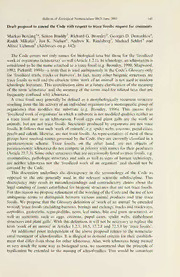
Draft Proposal To Emend The Code With Respect To Trace Fossils: Request For Comments PDF
Preview Draft Proposal To Emend The Code With Respect To Trace Fossils: Request For Comments
Bulletin ofZoological Nomenclature 60(2) June 2003 141 Draft proposal to emend the Code with respect to trace fossils: request for comments Markus Bertling'*, Simon Braddy^, Richard G. Bromley\ Georges D. Demathieu"*, Radek Mikulas^, Jan K. Nielsen*^, Andrew K. Rindsberg'', Michael Schlirf^ and Alfred Uchman' (Addresses on p. 142) The Code covers not only names for biological taxa but those for the 'fossihzed work oforganisms (ichnotaxa)' as well (Article 1.2.1). In ichnology, an ichnotaxon is considered to be the name attached to a trace fossil (e.g. Bromley, 1990; Magwood, — 1992; Pickerill, 1994) a term that is used ambiguously in the Code's Glossary only for 'fossilized trails, tracks or burrows'. In fact, many other biogenic structures are trace fossils as well and the obsolete term 'work ofan animal' is not used in modern ichnologic literature. This contribution aims at a future clarification ofthe meaning of the term 'ichnotaxa' and the meaning ofthe terms used for related taxa that are frequently confused with ichnotaxa. A trace fossil may generally be defined as a morphologically recurrent structure resulting from the life activity ofan individual organism (or a monospecific group of organisms) that modifies the substrate (e.g. Bromley, 1996). This means that 'fossilized work oforganisms' inwhich a substrate isnotmodified qualifies neitheras a trace fossil nor as an ichnotaxon. Fossil eggs and plant galls are the work of animals, but are not trace fossils. Secretions produced by organisms are not trace fossils. It follows that such 'work ofanimals', e.g. spider webs, cocoons, pupal cases, pearls and calculi, likewise, are not trace fossils. As representatives ofmost ofthese groups have received names governed by the Code, they are currently classified in a parataxonomic scheme. Trace fossils, on the other hand, are not objects of parataxonomy; ichnotaxa do not compete in priority with names for their producers (Article 23.7.3). Some other structures that are occasionally listed as trace fossils, e.g. stromatolites, pathologic structures and soils as well as signs of human technology, are neither ichnotaxa nor the 'fossilized work of an organism' and should not be covered by the Code. This discussion underlines the discrepancy in the terminology of the Code as opposed to the one generally used in the relevant scientific subdiscipline. This discrepancy may result in misunderstandings and contradictory claims about the legal standing ofnames established for biogenic structures that are not trace fossils. For this reason we propose refinement ofthe wording ofthe Code and the use ofless ambiguous terms to distinguish between various animal products and true trace fossils. We propose that the Glossary definition of 'work ofan animal' be emended to read: 'tracefossils (includingburrows, borings and etchings, tracks andtrackways, coprolites, gastroliths, regurgitaliths, nests, leafmines, bite and gnaw structures), as well as secretions such as eggs, cocoons, pupal cases, spider webs, embedment structures and plant galls'. With this definition, it will not be necessary to replace the term 'work ofan animal' in Articles 1.2.1, 10.5, 12.2.8 and 72.5.1 by 'trace fossils'. An additional point independent of the above proposal relates to the nomencla- tural treatment ofichnofamilies. It is illogical to demand criteria for their establish- ment that differ from those for other ichnotaxa. Also, with ichnotaxa being treated in very much the same way as biological taxa, we recommend that the principle of typification be extended to the naming of ichnofamilies. This would be consistent 142 Bulletin ofZoological Nomenclature 60(2) June 2003 with the current provisions for the typification of ichnogenera and ichnospecies (Articles 13.3.3, 42.2.1 and 42.3.2). In addition, we propose the deletion of an unnecessary sentence dealing with ichnotaxabasedonrecenttraces(Article 1.3.6). Thisarticleallows usageofichnotaxa erected on recent traces prior to 1931, but there seem to be no grounds for this provision. We are not aware of any case where names based on recent traces are actually used. Ifthey had been validly established they would no longer be available due to their status ofnomina oblita, anyway. Finally, numerous new ichnotaxa have been established in the last decades by their authorsusingthe abbreviations 'igen.' for ichnogenus and 'isp.' for ichnospecies. We advocate that 'igen.' and 'isp.' be approved as the legitimate abbreviations for ichnogenus and ichnospecies, respectively, for use in open nomenclature and for the designation ofnewichnotaxa. In relation to this, Recommendation 16A ofthe Code should be emended to include reference to 'igen. n.', 'isp. n.\ etc. for ichnotaxa. Comments on this draft proposal are invited and should be sent to the Executive Secretary, I.C.Z.N., c/o The Natural History Museum, Cromwell Road, London SW7 5BD, U.K. (e-mail: iczn(^nhm.ac.uk). References Bromley, R.G. 1990. Tracefossils: biology and taphonomy. 280 pp. Unwin Hyman. London. Bromley, R.G. 1996. Tracefossils: biology, taphonomy andapplications. 361 pp. Chapman & Hall, London. Magwood, J.P.A. 1992. Ichnotaxonomy: a burrow by any other name? Pp. 15-33 in Maples. C.G. & West, R.R. (Eds.). Trace Fossils. Palaeontological Society Short Courses in Palaeontology, 5. Pickerill, R.K. 1994. Nomenclature and taxonomy of invertebrate trace fossils. Pp. 3^2 in Donovan, S.K. (Ed.), Thepalaeobiologyoftracefossils. JohnsHopkinsUniversity Press, Baltimore. (1) Geological and Palaeontological Institute, University ofMiinster, Corrensstr. 24. D-48149 Miinster, Gertnany (*corresponding author). (2) Department ofEarth Sciences, University ofBristol, Bristol BS8 IRJ. U.K. (3) Geological Institute, 0ster Voldgade 10, DK-1350 Copenhagen K, Denmark. (4) Earth Sciences Centre, University of Burgundy, 6 boulevard Gabriel, F-21 100 Dijon, France. (5) Institute ofGeology, Academy ofSciences ofthe Czech Republic, Rozvojovd 135, CZ-16500 Praha 6, Czech Republic. (6) Geological Museum, 0ster Voldgade 5-7, DK-1350 Copenhagen K, Denmark. (7) Geological Survey ofAlabama, P.O. Box 869999, Tuscaloosa, AL 35486-6999, U.S.A. (8) Institutefor Palaeontology, Pleicherwall 1, D-97070 Wiirzburg, Germcmy. (9) Institute of Geological Sciences, Jagiellonian University, ul. Oleandry 2a, PL-30 063 Krakow, Poland.
